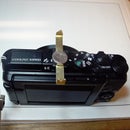Introduction: How Does Magnetic Field Vary With Distance?
This Instructabler is a scientific investigation to determine how magnetic field varies with distance. Two methods are presented , and reasonable conclusions made.
The magnet is a thin disk type, not a bar magnet.
- Tools and equipment:
- One rare earth neodymium magnet, 16mm diameter x 3mm.
- Precise scale measuring to 0.1 gram
- Balance beam apparatus to allow measuring magnetic attraction
- Magnetic compass
- Tape measure (non magnetic)
Note: This is a revision of an earlier Instructable by the same author. New data, analysis, and conclusions are presented to update and correct the previous Instructable, Determine how magnetic field varies with distance.
Some changes were also made in order to qualify for the Scientific Method contest on Instructables.com.
Step 1: Background: Inverse Square Law?
Many phenomena of nature, like light, obey the inverse square law. That means as you get farther away from the source of light, the intensity decreases as the square of the distance. The inverse square lawapplies to light, gravity, and electrostatic charge. And the equation is simpleand beautiful: basically it is I = 1/d2, where d is distance.
It is often assumed that the strength of a magnetic field also obeys the inverse square law.
Researching the Internet produces many complex equations, some suggesting that magnet field varies inversely with the third power of distance, in other words an inverse cube law.
I decided to test for myself.
Step 2: First Trial: Measure Magnetic Attraction Using Precise Scale and Plot Data
My initial method was to build a device that could measure magnetic force at various distances using a precise scale. I then would analyze data, plot a graph, and come up with an equation. It turned out to be not
that easy. The device is shown in the photo:
The magnet is attached at the end of a threaded brass rod, 32 threads per inch. The magnet is attracted to thecast steel surface of my table saw.
All other components are non-magnetic, brass, aluminum, wood.
Force is measured by the scale at 0.8 mm intervals over the full range the magnet is attracted to the steel, and recorded in a table.
After adjusting data due to geometry of the balance beam, I plotted these data using Microsoft Excel. I was impressed by the nice plot that resulted, but the more I looked at it the more confused I got. Excel offers an equation that agrees with the plot, but it was not a simple inverse square or inverse cube relationship. In fact, the only equation that really fit was a fifth order polynomial.
One key hint I learned: my measuring/testing system started to register a magnetic force at about 20 mm, the magnetic field extends much further.
Step 3: There Is No Simple Answer
I went to my math books to find a solution. Since I was looking for an exponent (the exponent is
-2 for an inverse square relationship) I decided to analyze these data. In the following equation, I needed to find exponent "m".
x^m = y
m Log x = Log y
m = Log y / Log x
Using the above equations, I analyzed data to determine exponent m for distances of 1.28 mm (almost touching the saw table) to 18.26 mm (magnet force barely detectable). Only at a distance of about 16 mm does the magnetic field follow the inverse square law (exponent = -2). As the magnet gets farther way from the saw table, the exponent gets larger, and is about -2.5 at 18.26 mm. I "guessed" that if my testing device was sensitive enough, the exponent would approach -3, which would indicate inverse cube law.
The plot of is shown on the chart.
At closer distances the exponent kept decreasing.
Step 4: The Most Precise Measurment: Use a Compass
My previous tests with the scale were inconclusive; the distance I could detect with my device only went to 18 mm.
I then decided to measure magnetic field using an ordinary compass. The basic setup is shown in the photo. You measure compass needle deflection at different distances, then find the exponent for the relationship using trig formulas provided.
After doing this test a few times and taking the average, the results are shown in the table below.
The table below shows the relationshio between magnetic force and distance, as measured by the compass needle deflection method. Distance is shown in mm; exponent is "m".
A really important point: the compass could detect magnet field at 356 mm, over seven inches away.
The average of the values of m is 3.05, indicating that as the magnet gets farther away, the exponent m is about -3, indicating that for this type of magnet only, the force from its magnet field varies inversely by the cube of distance.
Distance.....m
350 ....... -3.34
330....... -2.61
300...... -2.59
280...... -2.71
250...... -2.97
230...... -3.00
200....... -2.96
180...... -3.10
150...... -3.13
130 ...... -3.20
110...... -3.26
100...... -3.33
90..... . -3.38
Average: -3.05
Step 5: Conclusion: the Inverse Square Law Applies Only to Monopoles, a Magnet Is a Dipole.
Conclusion and summary:
The detailed shapes of the magnets are important. If I had used a bar magnet rather than a disc magnet the results would have been different.
The inverse square law results from monopoles, which are point-sources. Light and a single electrical charge are monopoles, so obey the inverse square law, expressed as 1/d^2, where d is the distance from the source to the point of measurement. A magnet is a dipole, and a disc magnet has two closely spaced magnetic poles. When measuring the magnetic field at various distances, the 1/d^2 terms cancel out and you end up with the next
biggest term, which is 1/d^3. This is an electric dipole field.
This experiment tends to prove that for the disc magnets tested, magnetic field varies inversely according to the third power of distance.

Participated in the
Scientific Method Contest













